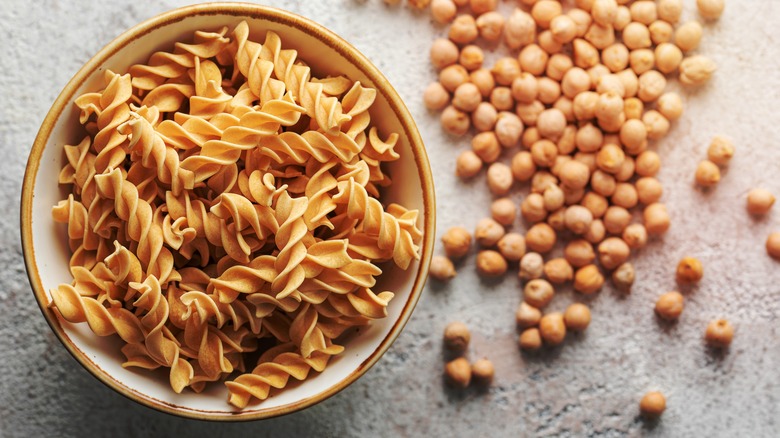What Does Chickpea Pasta Really Taste Like?
Whether you're gluten-free or just trying to incorporate more protein into your diet, you may have tried — or considered trying — chickpea pasta. This alternative pasta is widely available nowadays, as brands like Banza are commonly sold not only in specialty food stores, but also in regular, big-name grocery stores, making it an easy substitution for traditional wheat pasta.
But before you go chickpea-happy, there's one thing you're almost certainly wondering: Does the stuff taste good? If you've been let down by gluten-free alternative foods before, as so many of us have, your skepticism is completely warranted. However, we're pleased to tell you that if you've yet to taste chickpea pasta, it's worth a try.
Chickpea pasta boasts the mild, slightly nutty flavor of chickpeas, but, similar to wheat pasta, it possesses a fairly neutral flavor — ideal, considering pasta is often topped with all sorts of sauces and needs to be versatile. Where it most significantly diverges from standard pasta, however, is in texture. If you're expecting an exact clone of regular pasta, you might be disappointed. But if you can embrace the differences, you might just find a new go-to weeknight meal option.
Texture is everything
Chickpea pasta is a bit more flavorful than the regular kind, as chickpeas have a flavor that's still mild, but a bit more distinct than wheat, with some soft earthy, nutty notes. The difference in taste is noticeable but not overwhelming, and once you've added your favorite flavorful sauce recipe to the pot, the chickpea taste becomes even harder to detect.
As is often the case with gluten-free versions of old favorites, the texture of chickpea pasta is what's most noticeably different from wheat pasta. Even when thoroughly cooked, pieces of chickpea pasta tend to have a little extra stiffness, and a bit of graininess in the bite compared to the smoothness of wheat varieties. Whereas with regular pasta, you might prefer to err on the side of undercooking to ensure it's perfectly al dente, chickpea pasta usually benefits from boiling for the entire cooking time suggested on the package. Since chickpea pasta can be a little bit stiffer and more toothsome, even slightly undercooking it can result in some unpleasantly tough bites. It's not a major issue, but it is noticeable. Whether these differences are negligible or total deal-breakers, however, ultimately depends on personal taste — you just have to decide for yourself.
Wheat it and weep
Even if you're not entirely convinced by the flavor and texture of chickpea pasta, it's worth noting that it does have some significant advantages over other kinds of pasta — even traditional wheat pasta. As far as gluten-free pasta options go, chickpea pasta is quite durable. While rice noodles are at risk of deteriorating under the weight of heavy, creamy, or meaty Italian sauces, chickpea pasta can hold its own and won't break apart nearly as much when you toss it to incorporate the sauce.
From a nutritional standpoint, chickpea pasta surpasses wheat pasta, containing significantly more protein and fiber. For instance, a two-ounce serving of chickpea pasta contains 11 grams of protein, compared to the seven grams found in regular pasta, and it boasts eight grams of fiber, far exceeding regular pasta's mere two grams. If you can overlook the minor differences in taste and texture, you can effortlessly upgrade the nutritional value of your spaghetti dinners.


